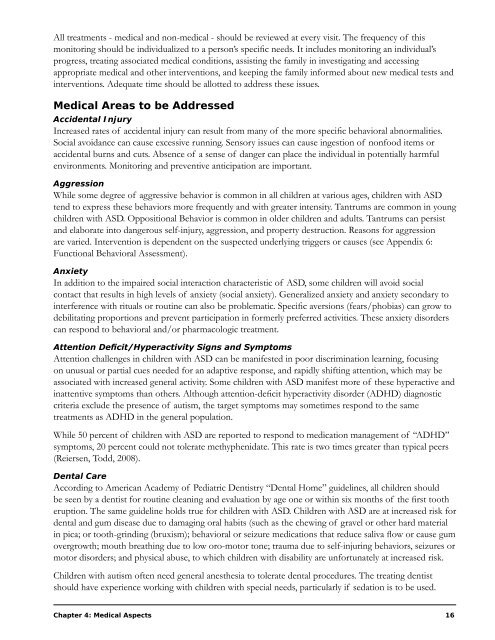Autism Guidebook for Washington State - Health Education ...
Autism Guidebook for Washington State - Health Education ...
Autism Guidebook for Washington State - Health Education ...
Create successful ePaper yourself
Turn your PDF publications into a flip-book with our unique Google optimized e-Paper software.
All treatments - medical and non-medical - should be reviewed at every visit. The frequency of this<br />
monitoring should be individualized to a person’s specific needs. It includes monitoring an individual’s<br />
progress, treating associated medical conditions, assisting the family in investigating and accessing<br />
appropriate medical and other interventions, and keeping the family in<strong>for</strong>med about new medical tests and<br />
interventions. Adequate time should be allotted to address these issues.<br />
Medical Areas to be Addressed<br />
Accidental Injury<br />
Increased rates of accidental injury can result from many of the more specific behavioral abnormalities.<br />
Social avoidance can cause excessive running. Sensory issues can cause ingestion of nonfood items or<br />
accidental burns and cuts. Absence of a sense of danger can place the individual in potentially harmful<br />
environments. Monitoring and preventive anticipation are important.<br />
Aggression<br />
While some degree of aggressive behavior is common in all children at various ages, children with ASD<br />
tend to express these behaviors more frequently and with greater intensity. Tantrums are common in young<br />
children with ASD. Oppositional Behavior is common in older children and adults. Tantrums can persist<br />
and elaborate into dangerous self-injury, aggression, and property destruction. Reasons <strong>for</strong> aggression<br />
are varied. Intervention is dependent on the suspected underlying triggers or causes (see Appendix 6:<br />
Functional Behavioral Assessment).<br />
Anxiety<br />
In addition to the impaired social interaction characteristic of ASD, some children will avoid social<br />
contact that results in high levels of anxiety (social anxiety). Generalized anxiety and anxiety secondary to<br />
interference with rituals or routine can also be problematic. Specific aversions (fears/phobias) can grow to<br />
debilitating proportions and prevent participation in <strong>for</strong>merly preferred activities. These anxiety disorders<br />
can respond to behavioral and/or pharmacologic treatment.<br />
Attention Deficit/Hyperactivity Signs and Symptoms<br />
Attention challenges in children with ASD can be manifested in poor discrimination learning, focusing<br />
on unusual or partial cues needed <strong>for</strong> an adaptive response, and rapidly shifting attention, which may be<br />
associated with increased general activity. Some children with ASD manifest more of these hyperactive and<br />
inattentive symptoms than others. Although attention-deficit hyperactivity disorder (ADHD) diagnostic<br />
criteria exclude the presence of autism, the target symptoms may sometimes respond to the same<br />
treatments as ADHD in the general population.<br />
While 50 percent of children with ASD are reported to respond to medication management of “ADHD”<br />
symptoms, 20 percent could not tolerate methyphenidate. This rate is two times greater than typical peers<br />
(Reiersen, Todd, 2008).<br />
Dental Care<br />
According to American Academy of Pediatric Dentistry “Dental Home” guidelines, all children should<br />
be seen by a dentist <strong>for</strong> routine cleaning and evaluation by age one or within six months of the first tooth<br />
eruption. The same guideline holds true <strong>for</strong> children with ASD. Children with ASD are at increased risk <strong>for</strong><br />
dental and gum disease due to damaging oral habits (such as the chewing of gravel or other hard material<br />
in pica; or tooth-grinding (bruxism); behavioral or seizure medications that reduce saliva flow or cause gum<br />
overgrowth; mouth breathing due to low oro-motor tone; trauma due to self-injuring behaviors, seizures or<br />
motor disorders; and physical abuse, to which children with disability are un<strong>for</strong>tunately at increased risk.<br />
Children with autism often need general anesthesia to tolerate dental procedures. The treating dentist<br />
should have experience working with children with special needs, particularly if sedation is to be used.<br />
Chapter 4: Medical Aspects 16
















